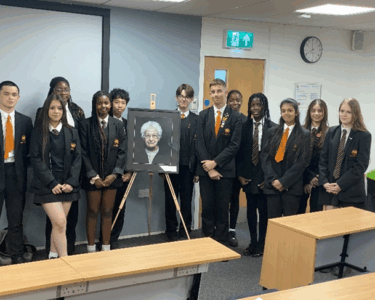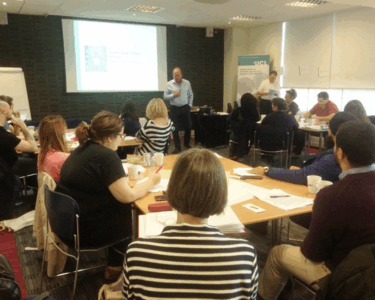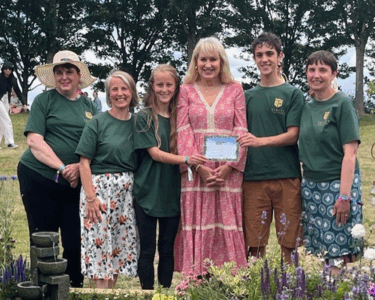A guest blog by By Domonic Townsend, Nottingham University Samworth Academy
& Lisa Grześkowiak
“My father spoke with his hands. He was deaf. His voice was in his hands. And his hands contained his memories.” (Myron Uhlberg)
Hello and welcome to my blog on delivering a curriculum to Deaf / deaf pupils in a mainstream secondary school.
The incredible team of the Focused Provision Unit (Deaf Base) and I strive each and every day to ensure that within our Humanities lessons, everyone has a voice, that the barriers of the past have been overcome and that the future of every pupil is brighter than ever before.
Being D/deaf, whether born deaf or through an event in your life, can leave you facing many challenges in a hearing world. People often assume that a hearing aid or cochlear implant means that a D/deaf pupil can access the same level of sounds as a pupil with hearing. This is not the case. For our D/deaf pupils and those across the country, they face many barriers daily, whether that be understanding the meaning of words, being able to track the dialogue of teachers or simply having cultural capital of specific current events or those of the past. These barriers mean that a D/deaf pupil must work twice as hard and think twice as hard compared to their hearing peers. This is why the Focused Provision Unit at NUSA are such incredible people who teach our D/deaf pupils the skills they need to overcome those barriers and are enablers of success.
The FPU not only seeks to enable our D/deaf pupils to access the curriculum but strives to create independent and resilient adults of the future. Working in collaboration between my Humanities Department and the FPU team, a ‘Ladder to Independence’ was created, with tiered levels of support for our D/deaf pupils which over time are reduced. This strategy has been successful in building self-confidence and resilience for our D/deaf pupils and has led to greater levels of academic independence and improvement as they move away from the blanket of support that previously covered them. I am also proud to say that over the past 8 years, every D/deaf pupil I have taught at GCSE has always succeeded, one pupil even achieving one of our highest ever grade 9s.
From the perspective of a Lead Teacher of a Beacon School (2021-22) there are a number of challenges I face in creating a Holocaust curriculum which is accessible for all, including D/deaf pupils. I started by initially creating a new unit of work which looks specifically at how deafness and disability has been viewed throughout history in our Year 8 curriculum. Not only does this unit serve as a precursor to the Holocaust unit by giving all NUSA pupils an understanding of how views around deafness and disability have changed over time, but it was also an opportunity to include authentic resources including the use of episodes from BSL Zone. For those that may not be aware, BSL Zone is a Deaf television programme made in British Sign Language made by Deaf people for Deaf people.
From there, Lisa (the Lead Teacher of the Deaf at the time) and I sat down and looked through my Holocaust scheme of work and picked out over 20 words linked to Holocaust vocabulary which do not have a British Sign Language (lexicon) representation (for now!). As a result, our D/deaf pupils would struggle to access the learning and to understand the meaning behind these particular words. Therefore, as a united force, History, the FPU and members of the D/deaf community, we have come together (in the style of the Fellowship of the Ring) to create a physical glossary of BSL signs which will enable the D/deaf pupils to engage with the learning in a way that is more accessible to them.
The formation and creation of BSL lexicons is a genuinely fascinating process to be part of, taking many hours of deliberation to come to a mutually agreed definition and sign that is not only understandable for the D/deaf community but also works as a definition within the history classroom. Take the term ‘concentration camp’, as two separate words they have very different meanings, then take the term in a historical sense and the word takes on multiple layers of complexity and contexts. Therefore, we had to follow a process for every historical based word to achieve the best possible outcome.
- Through a colleague trained in BSL, I defined each key word in a simple as possible manner while retaining its historical meaning-this was supported through visual images on the board and the word and definition displayed.
- My BSL trained colleagues then signed what I had described to the members of the deaf community (Simon and Ben)-who then discussed the word together through signs and through the use of the BSL online library. (Which I highly recommend viewing as a form of professional curiosity)
- How they perceived the words, and the possible signs was then relayed back to me and further conversations over the definitions took place.
- The BSL signs were then visually recorded, after multiple takes to ensure that the signs were as accurate as possible for members of the community to understand.
Sounds simple right? Wrong! The biggest challenge we faced as a fellowship was condensing the definitions into a few simple signs rather than spelling out the whole definition. A prime example of this was Kindertransport. ‘Childrens Transport’ in its simplest form of the word, but full of layers of meaning which we had to agree the BSL lexicon for, with the notion that an interpreter would help the D/deaf person to understand the meaning of it in more detail before using the sign on a regular basis. In order for this to be a successful project in creating the signs, it is vital that a class teacher delivers the context of the Holocaust terms in a manner in which is not only accessible to those who are not D/deaf but also provides the support staff and pupils with the time and opportunity to understand the word and its meaning. This same language development process also applies to EAL pupils for whom English is not there first language.
I am proud to say that I am now able to present to the Beacon School community and wider community, with a little (big) help from my friends, a glossary of videos to support teachers of the D/deaf around the country. They can be found on my NUSA school website, these will be further updated soon.
My hopes for the future are that in collaboration with the FPU team, we can create a truly outstanding Holocaust education and curriculum at NUSA. My next steps are working alongside a member of the FPU team to create a glossary of BSL signs that can be integrated across my entire History curriculum, in doing so we are able to celebrate BSL as an official language but as an integral part of creating a truly inclusive history education for all. Furthermore, we will proudly have a curriculum which gives all pupils, both D/deaf and hearing, the skills to break down their individual barriers and become members of society with the desire to change the world. In the words of the late Leon Greenman, MBE, we will ensure that “never again” will this world see another Holocaust.
Thank you to everyone out there who makes a difference to the lives of D/deaf people in the world and a special thank you to Ben Butterworth (Deaf Tutor at NUSA) and Simon Miller (BSL Development officer at Nottinghamshire Deaf Society) for making this fellowship and breakthrough possible.
As a school, we welcome anyone who wishes to see the fantastic work in place at Nottingham University Samworth Academy. Please feel free to reach out to me on X (Twitter) if you have any questions!
Domonic Townsend is a Humanities Teacher, and Beacon School Lead Teacher, at Nottingham University Samworth Academy (NUSA)
Learn more: https://www.nusa.org.uk/





